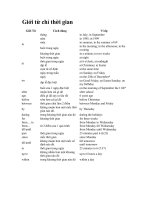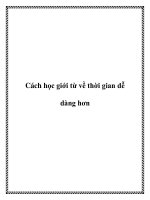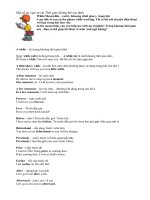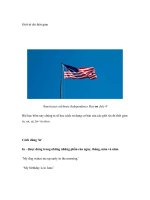Giới từ chỉ thời gian ppt
Bạn đang xem bản rút gọn của tài liệu. Xem và tải ngay bản đầy đủ của tài liệu tại đây (106.5 KB, 4 trang )
Giới từ chỉ thời gian
Giới Từ Cách dùng Ví dụ
in
tháng in July; in September
năm in 1985; in 1999
mùa in summer; in the summer of 69
buổi trong ngày
in the morning; in the afternoon; in the
evening
khoảng thời gian in a minute; in two weeks
at
buổi trong ngày at night
thời gian trong ngày at 6 o'clock; at midnight
dịp lễ at Christmas; at Easter
cụm từ cố định at the same time
on
ngày trong tuần on Sunday; on Friday
ngày on the 25th of December*
dịp lễ đặc biệt
on Good Friday; on Easter Sunday; on
my birthday
buổi của 1 ngày đặc biệt on the morning of September the 11th*
after muộn hơn cái gì đó after school
ago điều gì đã xảy ra lâu rồi 6 years ago
before sớm hơn cái gì đó before Christmas
between thời gian chia làm 2 điểm between Monday and Friday
by
không muộn hơn một mốc thời
gian nào đó.
by Thursday
during trong khoảng thời gian nào đó during the holidays
for khoảng thời gian for three weeks
from to
from
till/until
từ 2 điểm của 1 quá trình
from Monday to Wednesday
from Monday till Wednesday
from Monday until Wednesday
past thời gian trong ngày 23 minutes past 6 (6:23)
since mốc thời gian since Monday
till/until
không muộn hơn một mốc cố
định nào đó.
till tomorrow
until tomorrow
to thời gian trong ngày 23 minutes to 6 (5:37)
up to
không nhiều hơn một khoảng
thời gian nào đó
up to 6 hours a day
within trong khoảng thời gian nào đó within a day
Trạng từ: Trạng từ chỉ tần suất
Vị trí v cách dùng cà ủa tất cả các trạng từ. - Position of Adverbs!
arkblue">I. Adverb of Manner
(e.g.: slowly, carefully, awfully)
- These adverbs are put behind the direct object(túc từ trực tiếp)(or behind
the verb if there's no direct object).
S + V(s,es) + D.O + Adv Manner
Ex:He drove the car carefully.
Adverbs of Frequency answer the question "How often?" or "How frequently?"
They tell us how often somebody does something.
Adverbs of frequency come before the main verb (except the main verb "to be"):
• We usually go shopping on Saturday.
• I have often done that.
• She is always late.
Occasionally, sometimes, often, frequently and usually can also go at the beginning or end of a sentence:
• Sometimes they come and stay with us.
• I play tennis occasionally.
Rarely and seldom can also go at the end of a sentence (often with "very"):
• We see them rarely.
• John eats meat very seldom.
100% always
usually
frequently
often
50% sometimes
occasionally
rarely
seldom
hardly ever
0% never
He drove carefully.
II. Adverbs of Place
(e.g.: here, there, behind, above)
- Like adverbs of manner, these adverbs are put behind the direct object or
the verb.
S + V(s,es) + D.O + Adv Place
Ex: I didn't see him here.
He stayed behind.
III. Adverbs of Time
(e.g.: recently, now, then, yesterday)
- Adverbs of time are usually put at the end of the sentence.
S + V(s,es)+ I.O + D.O + Adv time.
Indirect object: túc từ gián tiếp
Ex: I will tell you the story tomorrow.
If you don't want to put emphasis on the time, you can also put the adverb of
time at the beginning of the sentence.
time subject verb(s) indirect object direct object
Ex: Tomorrow I will tell you the story.
IV. Adverbs of Frequency(
(e.g.: always, never, seldom, usually)
- Adverbs of frequency are put directly before the main verb. If 'be' is the
main verb and there is no auxiliary verb, adverbs of frequency are put behind
'be'. Is there an auxiliary verb, however, adverbs of frequency are put before
'be'.
S + V/ Be + Adv Fre + Main verb + O + ( place or time)
Ex: I often go swimming in the evenings.
He doesn't always play tennis.
We are usually here in summer.
I have never been abroad.









